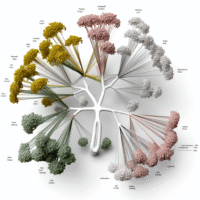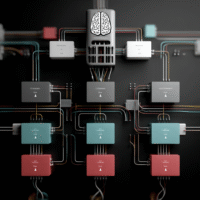Vladimir Dyachkov PhD
-
R-Zero: Revolutionizing AI Training with Autonomous Data Generation for Researchers and Executives
Understanding R-Zero: A Game-Changer in AI Training R-Zero is an innovative framework that redefines how we think about training AI systems, particularly large language models (LLMs). Traditional methods often rely on human-annotated datasets, which can be both time-consuming and limited by human expertise. R-Zero aims to overcome these challenges by enabling AI to generate its […] ➡️➡️➡️
-
ReaGAN: Transforming Graph Nodes into Autonomous Agents for Enhanced AI Decision-Making
Understanding ReaGAN: A Revolutionary Approach to Graph Neural Networks The introduction of ReaGAN marks a significant step forward in the field of artificial intelligence, particularly in how we utilize graph neural networks (GNNs). Developed by researchers at Rutgers University, ReaGAN transforms each node in a graph into an intelligent agent. This innovation allows for personalized […] ➡️➡️➡️
-
Salesforce Moirai 2.0: Revolutionizing Time Series Forecasting for Data Professionals
Understanding Moirai 2.0 Moirai 2.0, the latest innovation from Salesforce, is a powerful time series foundation model designed specifically for enterprise needs. Built on a decoder-only transformer architecture, it addresses common challenges faced by data scientists, business analysts, and IT professionals. The model is engineered to enhance forecasting accuracy, optimize operational efficiency, and streamline decision-making […] ➡️➡️➡️
-
Designing Intelligent Parallel Workflows with Parsl for AI Agent Execution
Understanding Intelligent Parallel Workflows In the realm of artificial intelligence, efficient execution of multiple tasks is crucial. This guide explores how to implement intelligent parallel workflows using Parsl, a Python library designed to enhance the execution of computational tasks. By leveraging parallel execution capabilities, we can run various independent tasks simultaneously, improving productivity and decision-making. […] ➡️➡️➡️
-
Top AI Models in Europe for 2025: Multilingual Innovations for Enterprises
Introduction to Europe’s AI Landscape in 2025 As we step into 2025, Europe stands at the forefront of artificial intelligence innovation, showcasing a diverse range of models that emphasize multilingual capabilities, openness, and enterprise readiness. This article explores the most advanced AI models developed in Europe, highlighting their unique features, strengths, and the impact they […] ➡️➡️➡️
-
Top 6 Essential Model Context Protocol Blogs for Developers and Enterprises in 2025
Understanding the Model Context Protocol (MCP) The Model Context Protocol (MCP) is rapidly becoming the standard for connecting AI applications to various tools and data sources. Often described as the “USB-C port for AI,” MCP aims to streamline the integration of AI agents with existing systems, replacing the need for multiple fragmented APIs. This article […] ➡️➡️➡️
-
Affordable AI Agents: Cost-Effective Strategies for Businesses and Researchers
As artificial intelligence continues to evolve, many businesses are grappling with the rising costs associated with deploying AI agents. A recent study by the OPPO AI Agent Team sheds light on this pressing issue, revealing that while advanced AI agents can perform complex tasks, their operational expenses are becoming a significant barrier for widespread adoption. […] ➡️➡️➡️
-
Dynamic Fine-Tuning (DFT): Enhancing Generalization in Large Language Models for Researchers and AI Practitioners
Understanding Dynamic Fine-Tuning (DFT) Dynamic Fine-Tuning (DFT) is an innovative approach designed to improve the limitations of Supervised Fine-Tuning (SFT) in large language models (LLMs). SFT has been widely used for adapting LLMs to specific tasks through training on expert datasets. While effective, it often struggles with generalization when compared to reinforcement learning (RL) methods. […] ➡️➡️➡️
-
Revolutionize Chatbot Testing with Snowglobe: The Ultimate AI Simulation Engine
Introduction to Snowglobe Guardrails AI has recently launched Snowglobe, a groundbreaking simulation engine aimed at enhancing the reliability of AI agents and chatbots. This tool addresses a critical challenge in conversational AI: the need for extensive testing before deployment. By simulating user interactions, Snowglobe allows developers to identify potential issues early, ensuring a smoother user […] ➡️➡️➡️
-
Google AI’s Gemma 3 270M: Efficient Fine-Tuning for Developers and Businesses
Introduction to Gemma 3 270M Google AI has taken a significant leap forward with the introduction of Gemma 3 270M, a compact model designed for hyper-efficient, task-specific fine-tuning. With its 270 million parameters, this model is tailored for immediate deployment, showcasing impressive instruction-following and text structuring capabilities. This makes it an ideal choice for those […] ➡️➡️➡️
-
Meta AI Unveils DINOv3: Revolutionary Self-Supervised Computer Vision Model for Researchers and Developers
Meta AI has recently unveiled DINOv3, an advanced self-supervised learning (SSL) model that is revolutionizing how we approach computer vision tasks. This new model sets a high bar for accuracy and versatility without requiring labeled data, making it particularly valuable in fields where annotations are limited or costly. Key Innovations of DINOv3 DINOv3 stands out […] ➡️➡️➡️
-
Top 12 API Testing Tools to Elevate Software Quality in 2025
Understanding the Target Audience for API Testing Tools The target audience for the top API testing tools in 2025 primarily includes software developers, quality assurance engineers, DevOps teams, and IT managers. These professionals operate in tech-driven environments where the integration and performance of APIs are crucial to business operations. They often face several pain points […] ➡️➡️➡️
-
Microsoft Unveils POML: Revolutionizing Prompt Engineering for AI Developers
In the rapidly evolving world of artificial intelligence, the introduction of the Prompt Orchestration Markup Language (POML) by Microsoft marks a significant advancement in how we interact with Large Language Models (LLMs). This open-source framework is designed to simplify and enhance the process of prompt engineering, making it more modular and scalable. Understanding POML POML […] ➡️➡️➡️
-
ByteDance Launches ToolTrain: Revolutionizing Code Search with Reinforcement Learning
Understanding ToolTrain: A Game-Changer in Code Exploration In the fast-paced world of software development, efficiency is key. As codebases grow larger and more complex, the challenge of pinpointing issues becomes increasingly daunting. Enter ToolTrain, a revolutionary tool-integrated reinforcement learning framework developed by researchers from Peking University, ByteDance, and Beijing Institute of Technology. This innovative solution […] ➡️➡️➡️
-
Build a Modular Conversational AI Agent with Pipecat and HuggingFace: A Step-by-Step Guide for Developers
Understanding the Fundamentals of Building a Conversational AI Agent In the age of AI, creating a conversational agent has become increasingly accessible thanks to frameworks like Pipecat and models from HuggingFace. This article will guide you through building a modular conversational AI agent from scratch, making it suitable for developers, business managers, and students alike. […] ➡️➡️➡️
-
Top 10 Must-Visit Websites for the Latest AI Agent News in 2025
In today’s fast-paced technological landscape, staying updated on artificial intelligence, particularly in areas like agentic AI and AI agents, is crucial for entrepreneurs, marketers, engineers, students, and tech enthusiasts alike. With numerous sources available, it can be overwhelming to determine where to find the most reliable and insightful information. Below, we’ve compiled a list of […] ➡️➡️➡️
-
Why Docker is Essential for Modern AI Development: Ensuring Reproducibility and Portability
Artificial intelligence (AI) and machine learning (ML) are rapidly evolving fields that present a unique set of challenges. One of the key hurdles practitioners face is ensuring reproducibility, portability, and environment parity in their workflows. This is where Docker, a popular containerization platform, becomes crucial. By breaking down the reasons why Docker is fundamental for […] ➡️➡️➡️
-
Mistral Medium 3.1: Revolutionizing AI Performance and Usability for Enterprises and Developers
Introduction to Mistral Medium 3.1 Mistral AI has recently launched Mistral Medium 3.1, a significant upgrade that enhances the performance and usability of large language models (LLMs). This new model not only showcases superior multimodal intelligence but also emphasizes enterprise readiness and cost-effectiveness. As Mistral continues to establish itself as a leader in the European […] ➡️➡️➡️
-
Reinforcement Learning Breakthroughs in Open-Weight LLMs for Software Engineering Automation
Introduction to Reinforcement Learning in Software Engineering The field of software engineering automation is undergoing significant transformation, largely due to advancements in Large Language Models (LLMs). Traditional methods often rely on proprietary models or expensive teacher-based techniques, which can limit the capabilities of open-weight LLMs in practical applications. A recent collaboration between Nebius AI and […] ➡️➡️➡️
-
NVIDIA ProRLv2: Revolutionizing Language Model Reasoning with Advanced Reinforcement Learning
What Is ProRLv2? ProRLv2 is the latest enhancement from NVIDIA in the realm of Prolonged Reinforcement Learning (ProRL). Its primary aim is to elevate the reasoning capabilities within large language models (LLMs). By increasing the reinforcement learning (RL) steps from 2,000 to an impressive 3,000, ProRLv2 systematically investigates how these extended RL efforts can open […] ➡️➡️➡️

















